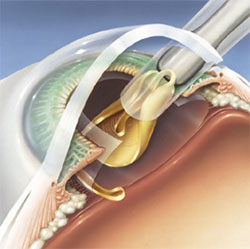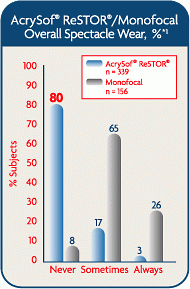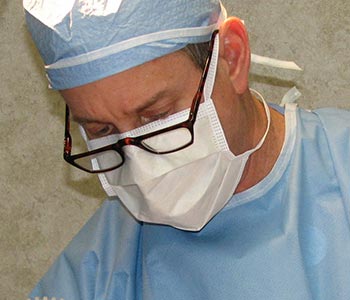Cataracts
Cataract Surgery and Treatment Options
Available to Patients in Houston, Pasadena, Webster, and Texas City, TX
The eye focuses images through a lens inside the eye – like a camera uses a lens to focus. When we are born, the lens is clear and flexible, allowing clear vision with a full-range of focus from near to far. As we age, the lens becomes cloudy and inflexible, causing our vision to blur and our dependence on glasses to refocus from far to near to increases. A cloudy lens is a cataract. Because of the clouded lens or cataract images may become blurry with age. Cataracts may make it progressively more difficult to read, drive, watch TV, perform normal daily activities and blur vision in general. Cataract formation is a normal unavoidable part of the aging process.

Symptoms of Cataracts
A cataract usually develops slowly and causes no pain. At first, the cloudiness may affect only a small part of the lens and you may be unaware of any vision loss. Over time, however, as the cataract gets worse, it clouds more of your lens. When significantly less light reaches your retina, your vision becomes impaired, decreasing vision with age.
- Blurred or double vision
- Seeing halos around bright lights
- Difficulty seeing at night
- Vision that worsens in sunlight
- Difficulty distinguishing colors
- Poor depth perception
- Frequent prescription changes for glasses
- Difficulty reading
Do You Have These Cataract Symptoms?






Deciding When to Have Cataract Surgery
Leave the cataract alone and continue to wait until your vision worsens. Cataracts are not like having life-threatening heart disease or cancer. Time is on your side. You can wait and leave your cataract alone. As long as you are not unhappy with your vision, leaving the cataract alone is acceptable and safe. If you choose to defer cataract surgery, your vision will remain blurred and the blur will only worsen as time passes. When your level of frustration with your blurred vision is no longer acceptable, then you can choose to have cataract surgery later.
Choosing the Right Lens For Your Lifestyle
Have cataract surgery to improve your vision. Cataract surgery is indicated when one’s vision is sufficiently blurry to impair one’s ability to see comfortably to perform their usual activities. If you choose to improve your vision through cataract surgery, you have a choice of intraocular lens implant (IOL) that you will receive:
A Standard Fixed-Focus Lens
Single Vision Intraocular Lens (IOL)
This type of intraocular lens, also known as a monofocal IOL, provides clear vision at one set focal length at distance or near. The distance lenses can provide excellent vision when driving or going to a ballgame, while the near vision lenses can provide good vision for reading or sewing. Unless one eye is set for distance vision and one set for near (monovision), you will probably need glasses for reading or other close-up activities.
Premium Toric Lens
Toric Intraocular Lens (IOL)
When a patient has significant astigmatism, a single vision IOL will not give clear vision at any distance. Patients with astigmatism have corneas that are not round, but rather oblong like a football. Toric IOLs have a unique design that offsets the imbalance of the corneal astigmatism. In this way, they can significantly improve distance (or near) vision in these patients who otherwise would need glasses after surgery.
A Premium IOL:
Premium Intraocular Lens (IOL) – Gives you a broader range of adjustable focus.
At Advanced Laser Vision and Surgical Institute, we offer the highest quality premium Intraocular Lenses (IOL’s) for our patients after their cataract surgery. All of these lenses have extraordinary quality however each lens will suit our patients in a different way. Please review the information below to find which premium lens may best suit your needs.
ReSTOR®
The ReSTOR® lens uses revolutionary apodized diffractive technology – a series of concentric circular rings that cause light to focus correctly on the retina and allows you to see at a distance and near. Clinical studies have shown that 80% of patients did not have to use glasses for any activity after surgery, while only 23% of the control group who received conventional IOLs achieved the same levels of visual acuity.
Tecnis®
The Tecnis® lens has the ability to consistently offer patients improved vision at a range of distances, from near to middle to far. The Tecnis® Lens is the only wave front-designed lens with FDA-approved claims for improved functional vision and improved night-driving simulator performance. The vast majority of patients with Tecnis® lenses will no longer need glasses, but some patients may still need glasses on occasion for certain tasks.ReSTOR® Multifocal Intraocular LensTecnis® Multifocal Intraocular Lens
ReSTOR® Multifocal Intraocular Lens

ReSTOR® Multifocal Intraocular Lens The AcrySof ReSTOR® Apodized Diffractive Optic Posterior IOL (ReSTOR®) is a permanent artificial lens. It is used in adult patients with and without presbyopia, who desire near, intermediate and distance vision with increased independence from glasses and contact lenses. The ReSTOR® lens is implanted in the eye as a lens replacement at the time of cataract surgery or refractive lens exchange.

BEFORE with monofocal vision 
AFTER with ReSTOR® IOL
Similar to other lens implant procedures, you can expect your vision to be good the day following surgery. There is minimal discomfort after surgery that usually resolves within hours. Most individuals can return to a normal work schedule/routine the day after surgery.
ReSTOR® Technology
The AcrySof ReSTOR® IOL has a patented optic design using apodization, diffraction and refraction technologies. The apodized diffractive optic design gives it the ability to focus light correctly on the retina for images at various distances without mechanical movement of the lens.
Apodization is a gradual reduction or blending of the diffractive step heights. This unique technology optimally manages light energy delivered to the retina because it distributes the appropriate amount of light to near and distant focal points, regardless of the lighting situation. Apodized diffractive optics are designed to improve

The ACRYSOF® ReSTOR® IOL is inserted in precisely the right spot, where the “arms” gently unfold to keep it in place.

The ACRYSOF® ReSTOR® IOL provides a range of vision from near to distance.
ReSTOR® Candidates
Virtually everyone who has cataracts and is in good general health may be candidate for implant surgery, but people with chronic infections, uncontrolled diabetes, or other health problems may have to wait until these conditions are under control prior to surgery.
People who have had prior corneal refractive surgery (i.e. LASIK or PRK) may be acceptable candidates for ReSTOR® implantation as long as their eyes are in good health. After a thorough examination, we will be able to better advise you if you qualify for the ReSTOR® implant.
If you’ve already had cataract surgery, you’re not a candidate for the ReSTOR® procedure.
There are no known contraindications. However, based on the FDA clinical trials, Alcon, the lens manufacturer, has indicated the following types of patients possibly should not have the AcrySof ReSTOR® Apodized Diffractive Intraocular Lens:
- Patients that are hypercritical with unrealistic expectations
- Patients with excessive complaints about their prescription
- Patients who drive at night for a living or whose occupation or hobbies depend on good night vision
- Patients who are amateur or commercial airline pilots
- Patients who have lifelong complaints about glare
- Patients who are happy wearing glasses
- Patients who want guarantees on surgical outcomes
View Frequently Asked Questions about the ReSTOR® Multifocal Lens by Clicking Here!
Clinical Results
The FDA-approved AcrySof ReSTOR® is a breakthrough in intraocular lens technology for most people with cataracts, with or without presbyopia, that may restore the eyesight of youth. Results from a controlled clinical study of the AcrySof ReSTOR® IOL revealed that maximum visual performance is achieved when implanted bilaterally.

Clinical data demonstrates that AcrySof ReSTOR® IOL greatly reduces dependence on glasses or bifocals:
- 80% of patients reported that after lens implant surgery with ReSTOR® lenses, they never needed glasses or contact lenses to see clearly at all distances
- 94% reported being able to drive or read the newspaper without glasses or contacts
- Nearly 94% were so satisfied that they would have the procedure again.
In addition, the quality of vision compared to wearing bifocals and/or trifocals is significantly improved. You’ll have a full range of vision, without having to tilt your head to find that portion of your glasses that allows you to see clearly.
Everyone’s focusing ability is different. Most people will be able to see clearly in the distance, have very good reading vision and functional intermediate vision without glasses, but some people may be more comfortable with additional correction, particularly at night or in dim light or for long periods of computer work.
After surgery with the ReSTOR® lens, it may be necessary for some people to wear glasses for distance, intermediate and/or near vision to obtain optimal visual acuity. The difference from standard lenses is that most people will not be as dependent on these supplemental vision aids to function normally.
What Are the Steps of the Cataract Surgery Procedure?
Today, almost all cataract patients have their cataracts removed using a surgical technique called phacoemulsification. Cataracts typically occur in both eyes, but they are usually treated one at a time, to allow the first eye to recover. There is usually an interval of several weeks or months between each operation, in some cases, longer.
The Operation

The operation usually lasts around 10 to 20 minutes. Cataract surgery is done under a local anesthetic which numbs the area. Your anesthesiologist will also give you a sedative, which will make you feel relaxed and possibly drowsy. Once the anesthetic has taken effect, your surgeon will make a tiny incision on the surface of your eye. This incision is usually so small that no stitches are needed.

Our doctor will use ultrasound energy to break up the cloudy lens (cataract), which can then be removed through a small tube. The lens sits inside a sac of thin tissue called a capsule. This is kept in place to support an artificial replacement lens, which will be inserted through the same incision.

Once the cataract is removed, a new lens must replace it. An artificial lens (the intraocular lens) will be put into your eye. It is folded to help insert it through the tiny incision. The intraocular lens will be unfolded once it is in your eye. The lens is made from plastic or silicone and remains permanently in your eye. These implants come in prescriptions just like eyeglasses and contact lenses. They come as a standard lens or a premium lens.

Once the lens is centered, our doctor verifies that the eye is at normal pressure and watertight. Under most circumstances, stitches (sutures) are not required to keep the incision sealed. The construction of the tiny surgical opening allows it to self-seal so that suturing is not necessary.
Post Cataract Surgery
You return home the day of surgery with a pair of protective glasses, with an appointment set for the very next day after your surgery. The first day, the vision is usually blurry and sometimes double; but within a few days, the vision clears. You can usually return to your normal activities within 48 hours, including showering, driving, shopping, cooking, and cleaning. Bending and lifting can be done on a limited basis immediately after surgery. Drops will need to be placed in the eye on a regular basis for three to four weeks after surgery to reduce inflammation. The eye will need to be protected with glasses during the day and a shield at night for the first three days. After one month, the lens for your glasses can be adjusted and your eye is completely healed.









